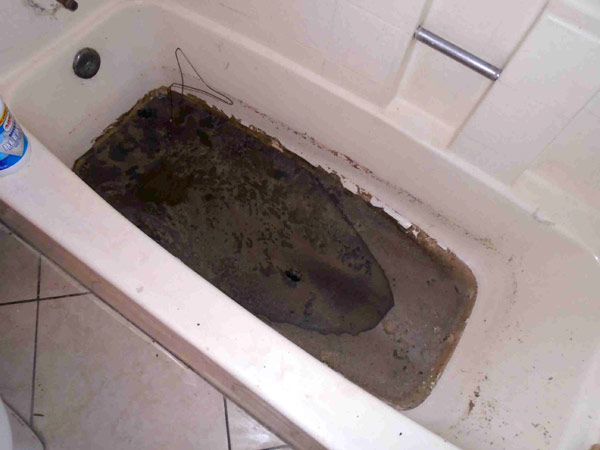We have come across this article pertaining to What to Do if Sewage Starts Coming Up Through Your Bathtub below on the net and concluded it made sense to relate it with you over here.

Sewage back-up in the bath tub can be a traumatic and unsanitary trouble for any property owner. Not only is it troublesome, yet it also postures major wellness dangers and indicates underlying issues with the plumbing system. Understanding why sewage is showing up through the bath tub is vital for taking appropriate activity to attend to the issue successfully.
Intro to the Issue
Common Factors for Sewer Backup
Blockages in the Drain Line
One of one of the most common reasons for sewage back-up is a clog in the sewage system line. This can take place as a result of the buildup of particles, oil, or foreign objects in the pipelines, stopping proper circulation and causing sewage to support into your tub.
Tree Root Intrusion
Tree roots looking for moisture and nutrients can penetrate drain lines with little cracks or joints. In time, these origins can grow and increase, causing considerable damage to the pipes and leading to sewage backup concerns.
Understanding the Problem
When sewage draws back up into the bath tub, it's a clear sign of a problem with the water drainage system. The wastewater that should be flowing away from your home is rather locating its back right into your living space, which can lead to considerable damage and health hazards.
Prospective Reasons
Several elements can contribute to sewer backup in the bath tub. From blockages in the drain line to problems with the plumbing facilities, identifying the root cause is important for locating a solution.
Aging Facilities
Older homes might have outdated plumbing systems that are extra at risk to rust, fractures, and degeneration. As pipes age, they end up being more prone to leakages and obstructions, boosting the possibility of sewer backup cases.
Heavy Rainfall or Flooding
Throughout periods of heavy rainfall or flooding, the sewer system may become overwhelmed with excess water, triggering back-ups and overflows. This can cause sewer supporting into tubs and various other fixtures inside the home.
Indications of Sewer Backup
Foul Odors
Undesirable smells emanating from drains or fixtures, particularly in the shower room, might show sewage back-up concerns. These smells are frequently strong and relentless, indicating a problem that requires instant interest.
Slow Draining Fixtures
Tubs, sinks, and commodes that drain pipes slowly or otherwise in any way could be experiencing sewer back-up. If numerous components are influenced simultaneously, it's likely that the concern originates from a typical point, such as the main sewer line.
Gurgling Noises
Weird gurgling or bubbling noises coming from drains pipes when water is running somewhere else in the house are a sign of air entraped in the plumbing system. This air buildup can arise from sewage backup and should be checked out quickly.
Health Dangers Connected With Sewer Backup
Contamination of Supply Of Water
Sewage backup can contaminate the water supply in your home, posing a serious wellness risk to you and your family. Direct exposure to contaminated water can result in gastrointestinal issues, skin infections, and other ailments.
Mold and mildew Development
Wetness from sewage back-up can develop perfect conditions for mold development in your home. Mold and mildew spores can worsen respiratory system issues and create allergies in sensitive people, making timely cleanup vital.
Spread of Disease
Sewer consists of hazardous bacteria, viruses, and bloodsuckers that can cause a variety of conditions, including hepatitis, cholera, and gastroenteritis. Coming into contact with sewer or contaminated surfaces puts you at risk of infection.
Cleaning Up After Sewer Backup
Sanitation Procedures
Thoroughly decontaminate and disinfect impacted locations after sewer backup to eliminate harmful bacteria and prevent mold development. Usage appropriate cleaning items and safety gear to ensure secure and reliable cleaning.
Restoration of Affected Areas
Fix any kind of damage to flooring, walls, or components caused by sewage backup. Relying on the extent of the damages, you may require to replace carpets, drywall, or other products to restore your home to its pre-loss condition.
Immediate Actions to Take
Switching Off Water System
In case of sewer backup, it's essential to switch off the supply of water to avoid more contamination and damage. Find the major water shutoff valve in your house and closed it off up until the issue can be resolved.
Contacting a Specialist Plumber
Handling sewer back-up is not a DIY work. Call a licensed plumber with experience in managing sewage-related problems to assess the circumstance and perform necessary repairs or cleanings.
Avoiding Contact with Infected Water
Until the sewage backup is dealt with, avoid contact with contaminated water to prevent the spread of germs and pathogens. Put on protective gear if you must be in the afflicted area and wash your hands completely afterward.
Safety nets
Regular Upkeep of Sewer Lines
Schedule normal examinations and maintenance of your drain lines to determine and address possible problems prior to they intensify right into significant problems. This can consist of cleaning out particles, checking for tree origin breach, and repairing any type of broken pipelines.
Setting Up Backwater Shutoffs
Take into consideration setting up backwater shutoffs in your plumbing system to stop sewage from receding into your home during durations of heavy rainfall or flooding. These shutoffs instantly close when water draws back up, shielding your building from contamination.
Correct Disposal of Home Waste
Prevent flushing anything aside from bathroom tissue and human waste down the commode to prevent clogs and obstructions in the sewage system line. Dispose of grease, oil, and various other household chemicals properly to lessen the threat of plumbing issues.
Why Is Water Backing Up in My Bathtub When I Flush My Toilet?
What to do about a sewer line clog
First, don’t bother with plunging. No amount of plunging will dislodge the clog in a sewer line. The clog is too far away. Plungers are for clogs in the toilet itself, not the sewer line. Plus, the most likely causes of a sewer clog are:
Tree roots Flushed toys or feminine products Grease buildup Those items don’t move easily. And in the case of tree roots, the roots need to be cut out of the pipe and the pipe will need to be repaired.
You’ll need a closet auger. A closet auger is a type of plumber’s snake with a protective cover to keep from scratching the delicate porcelain toilet. If the clog is further down, you may need to remove the toilet or use one of your cleanouts to get to the clog.
We also recommend doing a video inspection of the drain to ensure that the cause of the clog has been completely removed. Otherwise, you could have the same problem again in a few days or weeks.
https://mspplumbingheatingair.com/blog/why-is-water-backing-up-in-my-bathtub-when-i-flush-my-toilet

Do you like reading about Water Coming up Bathtub Drain? Create feedback directly below. We would be glad to know your insights about this piece. Hoping that you visit us again before long. I beg you take the time to distribute this entry if you liked it. We recognize the value of reading our article about Why is Sewage Backing Up Into My Bathtub?.
Visit Link
 Emilio Estevez Then & Now!
Emilio Estevez Then & Now! Amanda Bynes Then & Now!
Amanda Bynes Then & Now! Richard "Little Hercules" Sandrak Then & Now!
Richard "Little Hercules" Sandrak Then & Now! Elin Nordegren Then & Now!
Elin Nordegren Then & Now! Mason Reese Then & Now!
Mason Reese Then & Now!